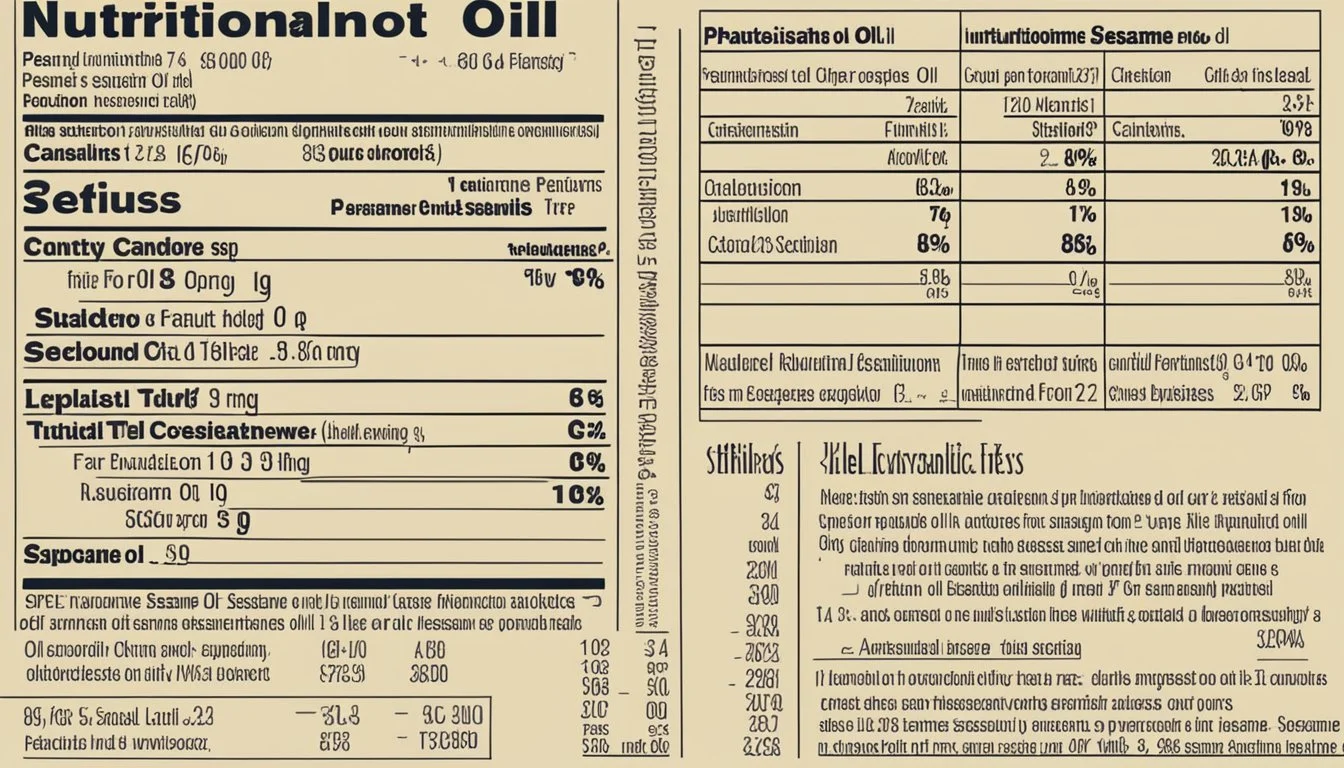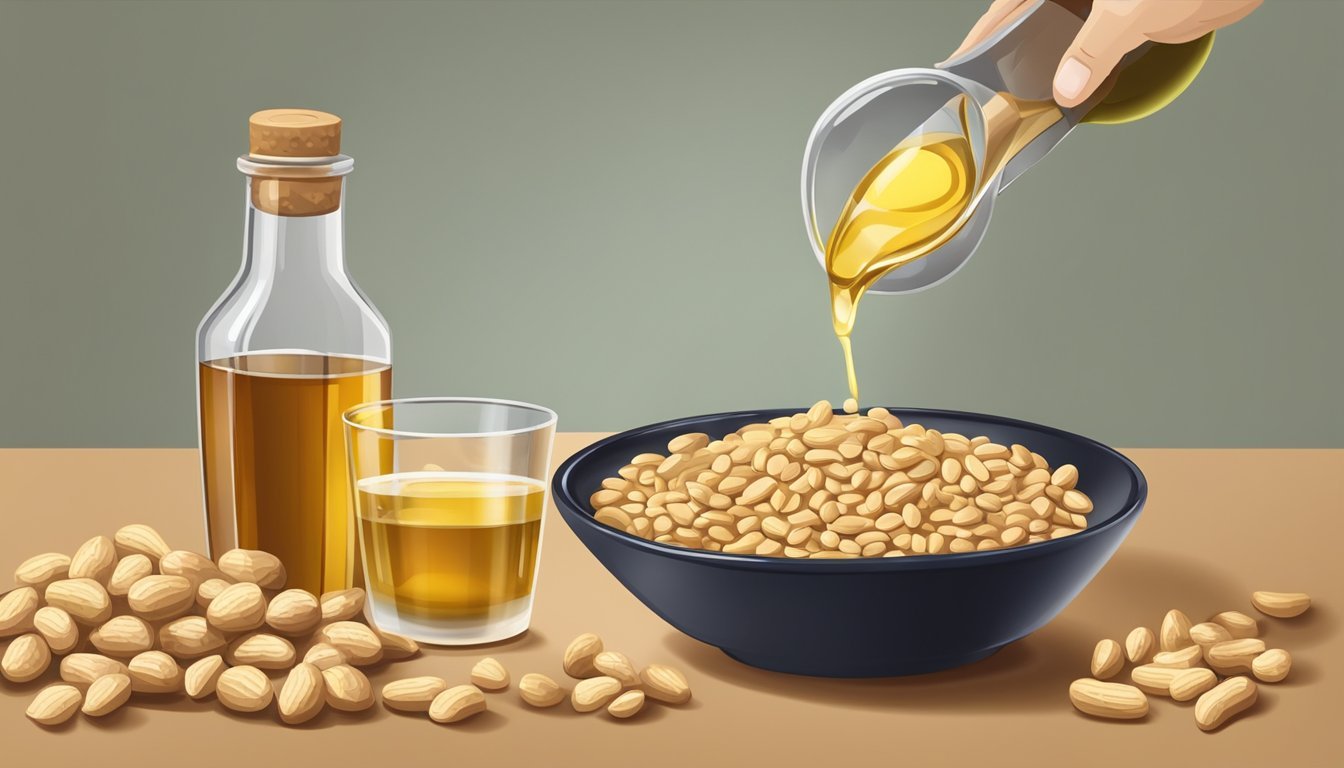How to Substitute Peanut Oil for Sesame Oil
A Simple Swap Guide
When it comes to cooking, the choice of oil can significantly affect the flavor and nutritional profile of a dish. Sesame oil, with its distinctive nutty flavor, is a staple in many Asian cuisines and is often used for its taste as much as its cooking properties. However, there are instances where cooks might need to find a substitute for sesame oil, either due to allergies, availability, or personal preference. In these cases, peanut oil presents itself as a viable alternative.
Peanut oil offers a comparable taste with a slightly nutty and more neutral profile, making it a suitable substitute for sesame oil in many recipes. It's especially handy in stir-fries, marinades, and dressings where sesame oil would typically be used. Its high smoke point also makes it ideal for deep-frying and pan-frying, providing a stable cooking medium that doesn't break down or smoke easily.
When substituting peanut oil for sesame oil, it's essential to consider the intensity of flavors. While sesame oil is often used as a finishing oil to lend a burst of flavor, peanut oil's more subdued taste might not fulfill the same role. However, this can be balanced by adjusting quantities or combining peanut oil with other ingredients to achieve a similar depth of flavor. Thus, cooks can confidently use peanut oil as a stand-in for sesame oil, keeping in mind the subtle differences in taste and how they may affect the finished dish.
Understanding Oils
When substituting oils in cooking, it's crucial to consider both the flavor and the cooking properties of the oils in question. Sesame oil and peanut oil possess distinct characteristics that can influence the outcome of a dish.
Characteristics of Sesame Oil
Sesame oil is extracted from sesame seeds and is valued for its nutty flavor. It comes in two main varieties: light sesame oil, which has a high smoke point appropriate for high-heat cooking, and toasted sesame oil, which has a lower smoke point and is commonly used for added flavor in dressings and sauces. Sesame oil is rich in antioxidants, including sesamol and sesamin, and has a good amount of vitamin E and anti-inflammatory properties, which are beneficial for one's health.
Properties of Peanut Oil
Peanut oil, derived from peanuts, offers a more neutral flavor compared to sesame oil, making it suitable for various culinary applications without overpowering other ingredients. It boasts a high smoke point, typically used for frying and high-heat cooking methods. Peanut oil is a source of vitamin E and has a balanced amount of omega-3 fatty acids, contributing to its nutritional profile. It's important to note that while the neutral flavor of peanut oil can accommodate many recipes, the unique nutty essence of sesame oil may be reduced when substituting with peanut oil.
Substitution Basics
When substituting peanut oil for sesame oil, one must consider the flavor profiles and cooking applications to maintain the integrity of the dish.
Flavor Considerations
Peanut oil and sesame oil differ significantly in taste. Sesame oil imparts a distinct nutty and rich flavor, especially when used as a toasted variety. Conversely, peanut oil offers a subtly sweet and mildly nutty taste, but is generally more neutral-flavored than sesame oil. This makes peanut oil a versatile substitute in dishes where the bold sesame flavor is not the centerpiece.
Sesame Oil: Distinct, robust, nutty
Peanut Oil: Mild, slightly sweet, less pronounced
Heat Tolerance and Usage
Both oils are suitable for high heat applications, but their usage can vary. Sesame oil, particularly toasted sesame oil, is often used as a flavor enhancer in the final stages of cooking or in dressings. Peanut oil's high smoke point makes it excellent for frying and other high-heat cooking methods without imparting a strong flavor, making it a practical cooking oil for a variety of cuisines.
Sesame Oil: Ideal for dressings and low-heat applications
Peanut Oil: Preferred for high-heat cooking, such as frying
Alternative Oil Options
When substituting peanut oil for sesame oil, it's important to consider the flavor profile and smoke point of the alternative oils. The goal is to maintain the integrity of the dish while incorporating oils that offer similar properties to sesame oil.
Nut-Based Oil Alternatives
Walnut oil and almond oil are nut-based oils that can serve as suitable substitutes for sesame oil, especially when a recipe calls for a nutty flavor.
Walnut oil: It has a rich, nutty flavor that complements salads and finishing dishes, though its lower smoke point makes it unsuitable for high-heat cooking.
Almond oil: Often used in dressings and desserts, almond oil imparts a subtle, sweet nuttiness, with a moderate smoke point appropriate for sautéing.
Seed and Other Oil Alternatives
Seed-based oils, along with certain other types of oils, provide alternative options that can often be used in a 1:1 substitution ratio for sesame oil.
Canola oil: A versatile oil with a neutral taste and high smoke point, suitable for frying and baking.
Avocado oil: Boasts a high smoke point, thus perfect for high-heat cooking, and its mild flavor won't overpower dishes.
Grapeseed oil: Features a clean taste and a moderate smoke point, fitting for dressings and medium-heat cooking.
For those seeking a variety of vegetable oils:
Oil Name Ideal Use Note Coconut oil Baking, sautéing Offers a distinct, sweet flavor. Sunflower oil General cooking High smoke point; neutral taste. Flaxseed oil Cold dishes, like salad dressings Not suitable for high heat. Safflower oil Frying, sautéing, baking Has a high smoke point. Hemp seed oil Salads, cold dishes Provides a grassy flavor. Pumpkin seed oil Salad dressings, finishing oil for dishes Not recommended for high-heat use.
Each oil comes with its own set of characteristics that can affect the final outcome of the dish, so chefs and home cooks should select their oil based on the intended flavor and cooking method.
Nutritional Profile Comparison
When substituting peanut oil for sesame oil, one should consider the nutritional profiles of both oils. Peanut oil is rich in monounsaturated fats, which are heart-healthy fats that can lower bad cholesterol levels in the blood. It also has a modest amount of polyunsaturated fats, including omega-6 fatty acids, but is low in omega-3 fatty acids.
Sesame oil, on the other hand, contains a significant amount of both monounsaturated and polyunsaturated fats. Notably, it has higher concentrations of antioxidants than peanut oil, including sesamin and sesamol, which are unique to sesame seeds. These antioxidants may have several health benefits, including combating inflammation.
Both oils provide vitamin E, an antioxidant that helps protect the body's cells from damage. However, peanut oil is generally higher in vitamin E compared to sesame oil. Here is a tabulated comparison of their vitamin E content:
Oil Type Vitamin E (alpha-tocopherol) Peanut Oil High Sesame Oil Moderate
As for health benefits, monounsaturated fats and vitamin E can contribute to cardiovascular health and overall well-being. Antioxidants found in sesame oil could offer an edge in terms of anti-inflammatory properties, although both oils may contribute beneficially when included as part of a balanced diet.
Cooking and Preparation Guidelines
When substituting peanut oil for sesame oil, one must consider the differences in flavor and smoke point to achieve the desired culinary results across various cooking methods.
Adjusting Quantities for Substitution
Peanut oil can be used as a one-to-one substitute for sesame oil. Due to its neutral flavor and high smoke point, peanut oil provides versatility in the kitchen, suitable for high-heat cooking techniques such as stir-fries and frying. It's important to remember that, while peanut oil lacks the distinctive nutty taste of sesame oil, it does not greatly alter the taste profile of most dishes.
Best Practices for Cooking Techniques
For sautéing vegetables or creating a marinade, peanut oil's subtle taste ensures it does not overpower other ingredients. Its high smoke point lends itself well to baking and frying, maintaining stability at high temperatures without burning.
Stir-fries: Use peanut oil directly as a sesame oil substitute; its high smoke point means it can withstand quick cooking at high temperatures.
Sauces and Salad Dressings: If the sesame flavor isn't critical, peanut oil can suffice. However, for a hint of sesame, consider adding a sprinkle of toasted sesame seeds to retain some character.
Marinating: Peanut oil's neutral taste ensures that the primary flavors of the marinade will stand out, making it an effective base oil.
Here is a quick reference table for substituting peanut oil in common applications where sesame oil is typically used:
Use Case Substitution Instruction High-heat cooking Substitute in a 1:1 ratio, excellent for frying Baking Use as a one-to-one substitute Salad dressings Can replace sesame oil, mildly affects flavor Stir-fries One-to-one substitution, high smoke point is ideal Sauces Substitute equally; add sesame seeds if desired Marinade Use peanut oil for a more neutral flavor profile
Each application benefits from the high smoke point and neutral flavor of peanut oil, ensuring dishes are cooked effectively with minimal impact on overall flavors.
Specialty Uses of Sesame Oil
Sesame oil, particularly toasted sesame oil, plays a pivotal role in Asian cuisine, offering a distinctive nutty flavor. It is important to differentiate between the types of sesame oil when considering their specialty uses.
Asian Cuisine Applications
In Asian cooking, sesame oil is a cornerstone, especially present in Korean and Middle Eastern cuisine. The flavor profile of sesame oil varies depending on whether it's light or dark (toasted). Light sesame oil has a milder taste and higher smoke point, making it ideal for stir-fry and marinades.
Toasted Sesame Oil: Its intense and richer taste is preferred in Asian dishes to enhance the final dish as a finishing oil.
Dark Sesame Oil: Suitable for its strong flavor, it's often used sparingly to augment soups and meats.
Asian cuisine frequently incorporates either sesame oil into dishes to contribute a distinctive, deep flavor that is difficult to replicate with other oils.
Unique Recipes and Finishing Touches
Sesame oil is not only significant in traditional recipes but also shines as a finishing touch to elevate the taste of a dish.
Sesame Paste: Often mixed with extra virgin olive oil to create dressings or dips.
Toasted Sesame Seeds: May be added to the oil to infuse it with a robust aroma, particularly in dressings or when mixed with seasonings for a flavorful crust on meats.
When used as a finishing oil, sesame oil should be drizzled over dishes just before serving to preserve its distinct essence. Despite its strong character, sesame oil harmoniously blends into marinades and sauces, providing a subtle yet undeniable presence that enhances the overall dish.
DIY and Homemade Alternatives
In this section, the focus is on creating homemade sesame oil substitutes, whether that involves crafting a sesame-flavored oil using alternative ingredients or preparing flavored oils to mimic the unique taste of sesame oil.
How to Make Your Own Sesame Oil Substitute
To create a substitute for sesame oil at home, one can toast sesame seeds until they are golden and aromatic and then combine them with a neutral-flavored oil, such as canola or sunflower oil. Here's a simple step-by-step process:
Toast Sesame Seeds: Place ¼ cup of white or black sesame seeds in a dry, hot pan over low heat. Stir continuously to avoid burning.
Observe Color: Once they turn a toasty brown and emit a nutty fragrance, remove them from the heat.
Blend with Oil: Mix the toasted seeds with one cup of a neutral oil in a blender until the mixture is smooth.
Strain (Optional): For a clearer oil, strain the mixture through a fine-mesh sieve or cheesecloth.
This homemade oil won't be as concentrated as commercial sesame oils, particularly not as potent as extra virgin or untoasted sesame oil, but it will lend a similar toasty and aromatic quality to dishes.
Crafting Flavored Oils at Home
Flavored oils can add a hint of sesame-like aroma to recipes when sesame oil is not available. One may consider using perilla oil – derived from the perilla plant, which is related to sesame and has a comparable flavor profile. To craft your own flavored oils:
Select a Base Oil: Choose a light, neutral oil as your foundation, such as grape seed or canola oil.
Infuse with Flavor: Add ingredients that impart an aromatic quality reflecting that of sesame, such as toasted sesame seeds or a small amount of ground perilla seeds.
Heat Gently: Warm the oil-seed mixture on low heat to allow the flavors to infuse without burning the seeds.
Cool and Store: Once the desired flavor intensity is achieved, let the oil cool before bottling. Store your infused oil in a cool, dark place.
Infused oils should be used in moderation due to their intense flavor and should be prepared with food safety in mind to prevent spoilage.
Allergy Considerations and Safe Practices
When considering substitutes for sesame oil in cooking, it's essential to take into account individual allergies to nuts and other oils. Selecting a suitable non-nut oil alternative can offer a safe solution for those with such dietary restrictions.
Identifying Nut Allergies and Intolerances
Individuals with nut allergies must exercise caution when selecting oil substitutes. While refined peanut oil may be safe for some people with a peanut allergy due to its minimal protein content, for those with a severe intolerance, even trace amounts can trigger an allergic reaction. It is important for individuals to:
Consult with an allergist to accurately identify specific nut allergies and understand the potential for cross-reactivity.
Read labels meticulously since even non-nut oils can sometimes be processed in facilities that handle nut oils, thereby posing a risk of contamination.
Non-Nut Oil Substitutes for Sesame Oil
For those avoiding nut oils due to allergies or intolerances, several non-nut oil alternatives can provide a similar flavor or texture to sesame oil. Here are the best substitutes for sesame oil along with their characteristics:
Avocado Oil: A high smoke point makes it ideal for high-heat cooking, and it substitutes well in a 1:1 ratio.
Olive Oil (Light): While different in flavor, light olive oil can behave similarly to sesame oil in recipes that do not rely on sesame oil's distinct taste.
Canola Oil: A neutral taste and a moderate smoke point, good for various cooking applications.
Choosing the appropriate substitute hinges on understanding that while some oils offer similar cooking properties, they may not impart the distinct nutty flavor characteristic of sesame oil.
Storage and Shelf Life
When substituting peanut oil for sesame oil, it is important to consider the storage and shelf life of peanut oil to maintain its quality and rich, nutty flavor. Peanut oil should be stored in a cool, dark place to prevent it from becoming rancid. A pantry or a cupboard away from heat sources and light is ideal. Once opened, keeping the oil in an airtight container can help prolong its freshness.
Shelf life details for peanut oil are as follows:
Unopened: The average shelf life of peanut oil, when stored properly in a cool, dark location, is up to 18-24 months.
Opened: Once opened, peanut oil will generally stay at its best quality for about 6 to 12 months.
It is important to note the following points when considering storage:
If the kitchen tends to be warm, or for long-term storage, placing the oil in the refrigerator can extend its usability. However, refrigeration can lead to cloudy oil, which will clear up when returned to room temperature.
Peanut oil doesn't solidify at colder temperatures as some other oils do, which makes it convenient for repeated use.
For those who prefer sesame oil's distinct nutty flavor, proper storage ensures that peanut oil remains a suitable culinary substitute. To maximize shelf life, both oils should be kept away from direct sunlight and heat, as these factors can accelerate the degradation of oil quality.
Final Thoughts
When substituting peanut oil for sesame oil, a chef can proceed with confidence knowing that the replacement will perform admirably in terms of cooking applications and health benefits.
Cooking Compatibility:
Peanut oil offers a high smoke point, making it well-suited for frying and sautéing.
Its neutral taste ensures that it won’t overpower the dish’s intended flavors.
Health Benefits:
Peanut oil is comparable to sesame oil, rich in monounsaturated fats that contribute to heart health.
Usage Ratio:
One can use peanut oil in a direct 1:1 ratio as a substitute for sesame oil.
Taste Considerations:
While sesame oil has a distinctive, nutty flavor, peanut oil is more subtle and may lack sesame oil's depth. For dishes where sesame flavor is a must, a cook might consider adding a small amount of toasted sesame seeds to bring in that nutty profile.
Culinary Balance:
Chefs should assess the overall flavor profile of their dishes, recognizing that while peanut oil can replace sesame oil from a cooking standpoint, the final taste may be slightly altered.
By being methodical in their approach, chefs can seamlessly integrate peanut oil into recipes that traditionally call for sesame oil without compromising the dish’s integrity. They should keep in mind the sensory balance and nutritional impact, making adjustments to other ingredients as needed to achieve the desired harmony on the plate.








